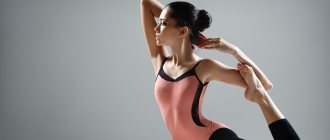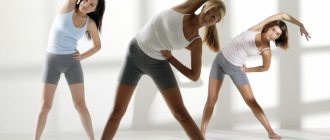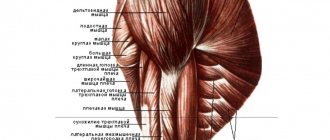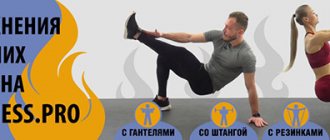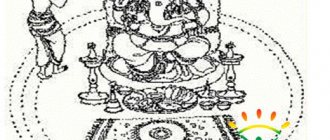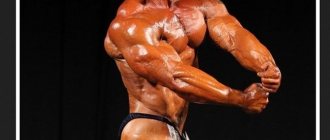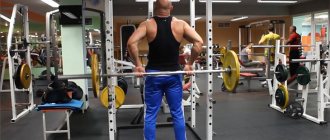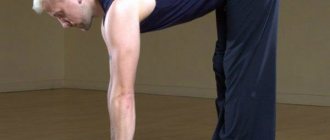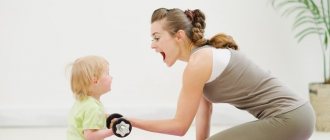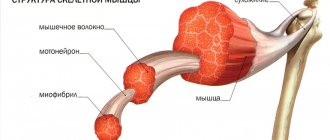March 11, 2020 Admin Home page » Training details
Have you just come to the gym and don’t know how to properly pump up your biceps? Find out the 4 main mistakes that will block your results.
All newcomers who come to the gym first of all want a pumped up chest and a decent size of biceps, this is the first desired goal for which they rush headlong in the expectation that in a couple of months they will create arms 2 times larger than their own, but not knowing many pitfalls quickly They get disappointed, lose the desire to train further and eventually give up going to the gym altogether.
In order not to step on the same rake, remember 4 important mistakes that should be avoided during the training process:
Main Factor
Often people decide to go to the gym before the summer beach season and think that in a month of intense training their unprepared body will acquire wonderful shape. However, excessive loads can harm the body, which is not accustomed to such frequent exercise.
Therefore, traumatic situations most often happen to beginners. Sometimes the causes of pain and the fact that the arm at the elbow does not straighten after training can be a pathology of the joints, which a person might not even suspect until they make themselves felt after increased stress.
Don't start training your arms with your forearms
Never train your forearms up to your biceps because the humble forearm muscles are involved in many curls. Once these muscles get tired, it will be difficult for you to hold a cup of coffee in your hands, let alone a heavy projectile. Save the reverse curls, as well as the palm-up or palm-down wrist curls, for the end of the workout.
In general, don't overload your forearms before training any large muscle group that requires a strong grip, including your back. Forearms should only be worked at the end of the training session.
Common causes of pain
Coming to the gym for the first time, a novice athlete diligently performs all the exercises given to him by the coach, so that he would not be ashamed in front of the experienced “jocks”. Naturally, the body, not accustomed to such stress, responds with pain throughout the body. Beginners believe that if their whole body hurts, it means they did a great job. But this is completely the wrong approach.
After training, the athlete should feel pleasant fatigue in the muscles, but not severe pain. Let's look at what happens in the human body after heavy loads:
- if the muscles are poorly warmed up and stretched, and a person begins to work on weight training equipment, then painful sensations may appear due to microcracks in the muscles, which become inflamed over time and become very painful;
- a person may experience burning-type pain. This suggests that you have overworked yourself. The tissues produce a lot of lactic acid, which interferes with normal blood circulation. At this time, there is a deficiency of oxygen, and the muscles refuse to perform contractile movements, which leads to the fact that the elbow does not straighten after training. Most often, this problem appears after intense exercises on the biceps of the arms;
- Sprains occur during sudden movements of the arms, for example, when jerking while lifting a barbell. This happens when the athlete spent little time warming up and warming up the muscles and did not do exercises to stretch the ligaments;
- Dislocation of the joint also causes severe pain and loss of movement of the limb. Here you definitely need to contact a specialist for help;
- poor metabolism in muscle tissue. This is a chemical process that breaks down proteins, fats and carbohydrates to release the energy needed for training. This releases toxins, which are normally eliminated through the capillary network. This requires a lot of oxygen. If the release occurs slowly, then all these decay products accumulate in the tissues, which leads to pain and malfunction of the elbow joint.
Why does my elbow hurt?
If during or after training a person experiences pain that is aching and monotonous, and he or she experiences numbness in the fingers, the cause of the pain in the elbow joints is most likely ulnar neuritis.
If the body is severely overloaded, the elbow joint can be severely damaged due to a fracture. In this case, the victim feels severe pain and cannot move the injured upper limb. You should immediately seek help from a traumatologist.
In addition, the reasons may be the following:
- Joints and ligaments can become inflamed due to the presence of diseases such as reactive arthritis, synovitis, bursitis. Fluid accumulates in the joint cavity, which leads to redness of the skin in the area of damage and a local increase in body temperature. The pain has a clear pulsation.
- If the elbow joint has been previously injured, a person may develop degenerative elbow disease or osteoarthritis. A similar disorder can occur if articular cartilage is lost. The patient also feels severe pain, the joint swells and loses mobility. Since such a disease spreads to the entire supporting apparatus, diagnosing osteoarthritis is quite simple.
- If you do frequent pull-ups or repeatedly perform the same movement during exercise, which puts a lot of strain on your elbow, you may develop epicondylitis. This disease is diagnosed when tissue is overstretched. In particular, epicondylitis is quite common among professional tennis players, since during training they have to make a monotonous movement, hitting the ball with a racket. The patient not only feels severe pain, but also cannot bend or straighten the elbow.
Most often, pain occurs after excessive repetition of the same type of movement. In particular, harm to the health of the joints can be caused by uncontrolled push-ups from the floor or frequent bench press, or when playing tennis, because there is a disease.
Due to the heavy load, small tears form in the tendon area, which accumulate, causing inflammation and pain. When scar tissue forms, proper blood flow to the extremities may be impaired. Elbow pain can be felt on the outside or inside of the limb, and can also be reflected down the arm.
Most often, pain occurs when tendons or muscles are strained. A person feels pain when he makes twisting movements in the forearm or wrist, especially if he is holding dumbbells at that moment.
The best way to treat pain is to find its source and treat it. If the necessary measures are not taken, the disease can become chronic.
Pathological factors
It may be painful to straighten your arm at the elbow after training due to diseases of the spine and joints:
- Osteochondrosis of the cervical and thoracic spine. Although mobility in the elbow is preserved, it is very painful to straighten and bend the arm.
- Epicondylitis of the elbow joint. This is an inflammatory process of the tendons after intense physical exertion. It manifests itself as pain in the elbow during grasping, rotational movements, or lifting a load. External changes are not visible, however, pain occurs on palpation.
- Arthrosis can be a consequence of a past injury or hormonal imbalances in the body. Pain occurs during flexion-extension movements, sometimes accompanied by a crunching sound. If treatment is not started in time, bone growths will form on the bone, which can subsequently lead to the fact that the elbow will no longer fully extend.
- Arthritic inflammation of the joints can lead to the arm not straightening at the elbow after training. The painful area swells and the skin color changes.
5. Bursitis can develop as a result of arthritis. Swelling appears on the back of the elbow from the accumulation of fluid in the synovial bursa of the olecranon.
Let's start with the chest muscles
Namely the pectoralis major and minor muscles. It starts on the sternum and ribs and is attached to the humerus on the outside (Fig. 1)! The shortened state of this muscle pulls the shoulder joint forward, rounding the back in the thoracic region and moving the shoulder blades away from the spine.
Stretching this muscle is extremely necessary for us cyclists!
Exercise.
Choose a place to support your hand. The hand should be higher than the shoulder. Bend your elbow slightly. The humerus is turned with the biceps upward. The body forms a straight line with the arm when viewed from top to bottom. We begin to smoothly turn away from the hand and “lean” forward a little. There is a feeling of stretching in the pectoral muscle and a pleasant pain! Hold this position for 30-40 seconds. Repeat for the second hand. It is necessary to repeat 2-3 times!
(Start)
(end)
Option 2
We stand in the doorway and rest our hands on the door frames. We try to go forward and lean down a little. There is a feeling of stretching in the pectoral muscle and a pleasant pain! Hold this position for 30-40 seconds. It is necessary to repeat 2-3 times!
(Start)
(end)
Latissimus dorsi muscle.
It starts from the lumbar and thoracic spine and is attached to the inside of the humerus (Fig. 2). In the shortened state, it pulls the shoulder down, turning it forward!
Exercise.
Choose a place for your hand so that you can grab it! We grab this place with our hand at a level just above the pelvis. We grab the chosen place so that the elbow is directed upward. We round our back in the thoracic region and turn away from the hand a little, and try to move as far as possible from the place where we are holding our hand. There is a feeling of stretching in the latissimus muscle and a pleasant pain! The larger the stretch area, the better. Hold this position for 30-40 seconds. Repeat for the second hand. It is necessary to repeat 2-3 times!
(Start)
(end)
Option 2
We stand against the wall. We rest our hand bent at the elbow against the wall. We lean on the wall and sink down. There is a feeling of stretching in the latissimus muscle and a pleasant pain! The larger the stretch area, the better. Hold this position for 30-40 seconds. Repeat for the second hand. It is necessary to repeat 2-3 times!
(Start)
( end)
For posture problems related to the hip joint, read the following article.
The author of articles is a personal trainer in fitness and bodybuilding. FPA course attendee and seminar participant. Conducts personal training, including cycling. Detailed information in a personal conversation, on VK (https://vk.com/id143637154)
Identifying the cause
You can understand the true reason why your arm does not straighten at the elbow after training after consulting a doctor. If the pain is temporary, then proper organization of loads and a good warm-up before the main activity will help. After training, it is advisable to massage the limb and rub the muscles to get rid of lactic acid in the tissues.
A hot shower will help you relax, and salt baths will help relieve stress and inflammation from your elbow. If the pain is severe and prolonged, then there is no need to hesitate; it is better to go to a therapist and check the condition of the joint.
Don't compensate for lack of intensity by increasing the duration of your workout.
Who hasn't seen a guy who spends hours doing biceps exercises because he's determined to get big cans.
Unfortunately, not a single experiment has proven that increasing training volume exponentially leads to equally effective mass gain. Simply put, more work does not equal more results.
Better keep your biceps-specific workout to 30 minutes—even less if you're a beginner. But it's not a matter of magically shortening the time; rather, it's a matter of choosing the right exercises, sufficient volume of load, working weight and rep range, training to failure, training techniques after muscle failure, and rest intervals.
If you're training your arms for longer than 30 minutes (about 12-15 sets), your workout is likely missing something. Focus on increasing the intensity of each set and don't try to compensate by increasing the volume. These two variables are not equal.
First aid for swelling
It may be painful for a healthy person to straighten the elbow after exercise due to the accumulation of lactic acid in the tissues. To relieve pain, reduce swelling in the elbow joint and return your arm to its former activity, you need to know how to provide first aid after training.
A fitness trainer may recommend that an athlete take a warm bath with sea salt. This will relieve muscle tension and joint inflammation. 15 minutes will be enough to complete the procedure.
Self-massage after training will restore blood circulation, remove numbness in the limbs and speed up metabolism. A steam room with a broom will help you recover well.
If the swelling is accompanied by a change in skin color or hematoma, then you need to urgently go to the doctor.
Triceps stretching: exercises in pictures and video
When it comes to arm muscles, triceps are often overlooked. Stretching your triceps arms, especially after weight training, will help eliminate or reduce delayed onset muscle soreness.
Triceps stretching warm-up
Muscles involved:
Triceps
Look at the video on how to properly stretch the triceps:
Triceps stretching is recommended to be performed after strength training, because... Stretching relaxes the muscles. When you perform a strength exercise, the muscles remain compressed after finishing. Recovery occurs during rest. Stretching allows you to reduce this time to a minimum.
Stretching the latissimus dorsi muscle
A simple triceps stretching exercise that can be included in any workout.
Variations:
You can pull one shoulder at a time.
Muscles involved:
Latissimus dorsi
Back Shoulder Stretch
Stretching the muscles of the back of the shoulder will be effective in treating shoulder injuries, as well as tension in the muscles of the upper back and neck, and stretching the triceps.
Muscles involved:
Posterior deltoid Supraspinatus Infraspinatus Rhomboid major
Stretch the back of the shoulder. Option No2
Muscles involved:
Supraspinatus Infraspinatus
Stretching exercise for the periosteum muscle
Muscles involved:
Periosteum muscle
First aid for a torn ligament
If after training you find that there is sharp pain in your elbow, swelling, a bruise, it is impossible to move your arm and elbow, and deformation of the elbow joint is visually visible, then most likely you have a ligament rupture. The first step is to apply cold to the sore spot, for example, ice wrapped in a napkin, and immobilize the arm by fixing it with a splint.
You can do a light massage around the elbow, but only where there is no pain. This will speed up blood flow and reduce pain. You should absolutely not take a hot shower or heat the rupture site. After a couple of days, when the pain subsides and the swelling subsides, you can apply warm compresses and begin working out your arm with smooth movements.
If it was not possible to cope with the problem at home, and the pain and swelling, on the contrary, only increase, you need to consult a doctor.
Hands and wrists
Exercise No. 1. Stretching the triceps (and even the shoulders and back)
- Starting position: standing, feet shoulder-width apart (for convenience).
- First, throw (raise) one arm (let's say the right one) back behind your back and bend it at the elbow.
- Now we pull up the second hand (left), that is, we take the right elbow with our left hand and begin to pull it carefully, slowly, under control, as far (deeper) as possible.
- Hold the stretch for as long as you can, and then repeat the exercise with the other arm.
Exercise No. 2. Stretch the biceps
- Kneel on the floor and place your hands down in front of you, fingers pointing towards your knees.
- The thighs almost touch the feet.
- Arch your back and lean back slowly, keeping your elbows motionless and your palms on the floor under control, so that tension (stretch) occurs in the muscles we need.
- Stay in this position (when it burns) for as long as you can.
- Then relax for 15-20 seconds and repeat the exercise several times (depending on how you feel).
Why do I have discomfort in my hands after training? 5 most common problems
If you have never trained, then after the first workout there is always pain and discomfort in the muscles. But after several regular workouts, the body adapts to the stress, and the discomfort disappears.
However, it often happens that some time after training you may feel discomfort in the muscles of your arms. They can manifest themselves in different ways. Let's look at the most common problems.
Feeling pain
My arms hurt after training, what should I do and what is the reason for this? Muscle pain can be due to natural causes, or it can be traumatic in nature. Natural reasons are:
- If you started training after a long break;
- We began to master new levels of loads;
- We started training for the first time, but the body did not adapt to the training.
- Pain occurs due to microtrauma of the muscles and the resulting inflammation.
Regular exercise is the best pain prevention! By the nature of the pain that occurs, you can understand the cause of its occurrence. Quite severe and constant pain most often indicates excessive and unbalanced stress. In this case, experienced trainers recommend performing all the usual exercises, but reducing the weight by half.
Post-traumatic pain, especially in the crooks of the wrists, makes it difficult to continue exercising and may worsen some time after training. This usually happens with a bad warm-up. Stop the exercise, rest the injured limb, and apply ice.
Pain that manifests itself as a burning sensation indicates that your muscles are being well worked out. This sensation is caused by lactic acid, which is excreted some time after the end of the workout.
Many people believe that pain after exercise is a good indicator. In fact, this is not the case, although moderate pain is considered acceptable in some cases.
You need to strive for pleasant fatigue in the muscles, to increase those indicators that you focus on (muscle girth, burning fat deposits, giving relief to those areas where your load is emphasized, etc.)
Massage and self-massage helps improve blood circulation, eliminate pain and muscle spasms.
We also recommend watching the video:
https://youtu.be/GklQIwUUWqc
Carefully! If you increase the load gradually, the body has time to get used to it and strengthen the muscles, ligaments and joints. Particular attention should be paid to the condition when the pain is caused by injury. The nature of the pain changes from stifling to acute. It can occur while performing the exercise or some time later.
Do not straighten at the elbow
Pain often occurs when bending the limb in the hand or in the elbow joint. Why don't my arms straighten after training? The reasons can be very different:
1. Load limit exceeded. A muscle spasm occurs, as a result of which the blood supply is disrupted and a lack of oxygen occurs. The muscle cannot contract, normal blood flow is disrupted, and lactic acid accumulates. Most often, it hurts to bend your arm at the elbow joint after biceps exercises.
Recovery usually takes place within ten days on average. Usually in this case, a special therapeutic restorative massage helps, which relieves spasm and restores normal blood flow;
2. Receiving microscopic injuries to muscle tissue. This happens when the muscles are not warmed up well enough before training. This is also facilitated by sudden movements, in which muscle fibers are forced to contract very quickly. In this case, the ligaments are sprained and are not ready for extreme stress. The reason for this could be, for example, a sharp rise in the barbell.
Special types of restorative massage give good results. By affecting muscles and tendons, it relieves pain and spasm, improves blood flow. A contrast shower is also useful, which must begin with a hot douche and end with a cold one, in the direction from bottom to top;
3. The formation of a slight dislocation of the wrist joint , occurring due to injury to the ligaments. It usually forms against the background of frequent sprains of the ligaments and tendons of the hand. Recovery requires rest and the use of salt compresses.
Dissolve two teaspoons of salt in one glass of water. We wet the towel, wring it out well and place it on the sore joint. On top is a dry towel folded in several layers. We do not use polyethylene; the fabric must ventilate naturally. This procedure must be done at night for a week.
In the future, you need to dose the load to avoid such injuries. During the recovery period, special exercises that the instructor can select for you individually are helpful. Recovery should be given the greatest attention, since if rehabilitation procedures are not followed, injuries can recur.
We recommend watching a useful video on this topic:
https://youtu.be/JbbLcmc46aE
Tremor
Why do my hands shake after training? Many factors can lead to this problem:
- Hunger, unbalanced diet;
- Severe fatigue, anxiety;
- Lack of night rest;
- Heavy physical activity;
- Incorrectly calculated exercise load.
Everyone has managed to encounter such troubles: hands shake after some time after severe muscle tension. This occurs when the natural alternation of muscle tension and relaxation is disrupted . For example, after the usual load has been increased, and the body has not yet had time to adapt to it.
In this case, it is necessary to take herbal remedies, such as valerian. Reduce the intensity of training for a while and take time to rest. If this does not help, you need to consult a doctor who, after examination, will give you recommendations and prescribe vasodilators and anticonvulsants.
If your problem is an unbalanced diet , you need to enrich your diet with proteins, carbohydrates, vitamins and minerals. Your diet must include fish, chicken, dairy products, herbs, and vegetables.
Learn more from the video:
https://youtu.be/DPM5Daht-NA
Swelling
Is your hand swollen after playing sports? This problem is familiar to many who, at the beginning of training, sought to quickly increase loads. The reasons are most often the following:
- The body does not have time to adapt to the rate of increase in loads. In this case, first of all, the ligamentous apparatus, as well as the muscles, suffer;
- Unbearable loads lead to sprains, tissue swelling and pain. If you have a sharp pain, and after a while your hand begins to swell, this indicates an injury.
- Joint disease can also cause swelling after exercise, so you will most likely need to consult a doctor;
In most cases, the hands become swollen after training due to the appearance of lactic acid. Fitness instructors recommend the use of warm baths with the addition of sea salt, contrast showers, bath procedures with a broom and self-massage techniques. Light gymnastic exercises will also be very useful in this case.
At the next workout, it is recommended to reduce the load and bring it to comfortable limits. In the future, increase it gradually, monitoring your well-being. Performing tension and relaxation exercises gives very good results, helps relieve tension and eliminate hand tremors.
Biceps stretch
Stretching these muscles is one of the main factors in their growth. Thanks to stretching, blood supply to the biceps improves and muscle recovery occurs much faster.
Biceps stretching exercises
1. Stand straight, place your feet shoulder-width apart, clasp your hands behind your back so that your palms face down. In this position, raise your arms up without bending your elbows. Keep your body straight and feel the stretch in your biceps.
Biceps stretch
2. Stand with your back to the door frame or horizontal bar post. Reach your hand back and grasp the joint with your thumb pointing up. Next, try to turn your arm with your biceps down, while keeping your hand in place. Switch hands and do the same.
3. To perform the next exercise you will need a horizontal bar. Grab it with a reverse grip and hang with your arms outstretched for as long as possible.
Stretching the triceps is also important for the growth of these muscles and the arms in general. The triceps give the arm most of its volume, so you should pay more attention to it.
Triceps stretching exercises
1. In order to perform the first exercise, we will need a towel. Take it in your hand and move it behind your head so that your thumb is pointing down. Place your other hand behind your back and grab the second edge of the towel. Pull the towel down until you feel a stretch in your triceps. Repeat this exercise for the other hand.
2. Stand up straight, put your hand behind your head, grab your elbow with your free hand and pull your hand towards your head, hold in this position, then repeat the exercise with the other hand.
3. Place your left hand on your right shoulder. With your right hand, grab your elbow and push your left arm toward your body. Then switch hands.
If you have a problem with posture, then shoulder stretching can correct this problem! Also, stretching the muscles of the shoulder girdle helps improve blood circulation in the upper body.
Shoulder stretches
1. Move your right arm, without bending it at the elbow, to your left shoulder. Repeat the same with your left hand.
2. Place one hand behind your head and the other behind your back and try to hook them into a lock. Stay in this position for a few seconds and then change hands.
3. Stand facing the wall, rest your hands on it. Place your hands as close to each other as possible. Move your feet away from the wall as far as possible. Lower your head down and bend in the lumbar region. You will feel a stretch in your shoulders, chest and spine.
Universal tips when playing sports
- A gradual increase in loads is the right approach that you need to pay attention to;
- Mastering the correct technique for performing each exercise. There are no small things in this! An incorrectly performed exercise can lead not only to muscle pain, but also to serious injury;
- It is mandatory to perform a special warm-up before starting training. Exercises should be aimed at the muscle groups that you will use in the workout. This will warm up the muscles, improve blood supply and prepare the ligamentous apparatus for stress;
- Contraindications for training are fatigue, poor health, and respiratory diseases. This is a signal: the body needs rest;
- Drink enough water. Thick blood creates an increased load on the heart, since it is not easy to pump through the vessels;
- Getting enough sleep will ensure your body recovers well after training. According to instructors, muscle pain can be caused by the fact that a person does not get enough sleep and the muscles do not receive complete relaxation;
When you start training, please take it seriously. If the loads are calculated correctly, then you will be able to achieve the results you dreamed of.
By neglecting the rules and advice of the instructor , instead of the desired results - a slim figure and sculpted muscles, you can harm your health. Systematically attending workouts without breaks will help your body get used to the stress. It will give you muscle joy and minimize pain. Use our tips and recommendations and be healthy, cheerful and joyful!
Nowadays it has become fashionable to lead a healthy lifestyle. Therefore, many men and women begin to eat right and also exercise to the best of their ability. However, without practical experience, it suddenly turns out that many nuances remain unclear. For example, the question of what to do if your arms hurt after training worries many beginners, and not only athletes. Let's look at the question together and finally give an answer to what is happening to our body and why such negative moments can be observed.
Don't start your workout with the wrong exercise
Can we say that some exercises are more suitable for starting a workout? Definitely! Typically, I recommend starting a class with a multi-joint movement. However, this is unlikely to apply to biceps, because even reverse-grip pull-ups work in tandem with the back muscles. The choice of exercises is largely limited to single-joint movements.
Among the single-joint exercises, you can find ones in which you can lift significantly more weight. This refers to bilateral movements in a standing position that involve both heads of the biceps. Isolation exercises, often performed while seated, are at the opposite end of the spectrum.
As an example, let’s compare the working weight in a standing biceps curl and a seated concentrated curl.
As an example, let’s compare the working weight in a standing biceps curl and a seated concentrated curl. The first will be an excellent starting exercise for training the biceps, the second is not suitable for these purposes. The standing barbell lift allows you to load your arms with maximum weight because you can use a small amount of momentum from your entire body to perform the movement. But you shouldn’t abuse the impulse, otherwise there will be nothing left of the correct technique.
Once you've chosen the right exercise, think about the load. If your goal is maximum hypertrophy, after your warm-up, use a weight that will allow you to reach failure in 8-12 reps. And since this is a starting exercise, you can even stop at the lower end of this range.
The main problems that arise in the hands after training
Unpleasant symptoms in the arm muscles usually arise for a reason. Most often this happens due to excessive overvoltage, incorrectly calculated, unbalanced load. Sometimes this phenomenon can be observed in athletes who have not had the opportunity to train for a long time.
If a person has never played sports before, then muscle pain may well occur. But soon, after the second or third training, it disappears by itself, leaving behind only a memory. The body gradually adapts to the load, so the discomfort disappears on its own. However, sometimes pain can return for various reasons, which we will consider in our article.
Feeling pain
If, after athletic training, the muscles begin to ache very much, even if the sensation is more aching than sharp, there are two types of causes that can be considered: natural and traumatic.
Natural causes
- Microtrauma to muscles during exercise can cause really severe pain.
- Mastering new types and types of loads.
- Start of a new training program after a rather long break. This is especially true for moments when you were interrupted to recover from illness or injury.
- For beginners, their muscles may ache out of habit.
Symptoms and their relief
By assessing your own condition, as well as the nature of the pain tormenting you, you can find the source of its occurrence.
- If pain torments you with enviable regularity, perhaps you have simply set unbearable load guidelines for yourself.
- If you are most concerned about unpleasant sensations in the bends of your wrists, most likely it appeared due to excessive strain or poor warm-up. To alleviate the condition, simply stop applying something cold to the sore spot for the duration of the training. Sometimes it’s enough to simply reduce all the loads, but everything is very individual.
- When the sensation is more like a burning sensation, then most likely it is a common sore throat, which any athlete knows well by sight. The cause is the production of lactic acid. This is normal; it is not very difficult to relieve the symptoms of this phenomenon. There is a lot of material about this on our website, it is worth studying in more detail.
It is inappropriate to judge the result of a workout by muscle pain. It is optimal to focus on the feeling of pleasant fatigue, and most importantly, on achieving your goals. This could be losing weight, building muscle, creating beautiful relief.
Do not straighten at the elbow or wrist
Some novice athletes say that their arms do not straighten after training. This problem is also relevant, and there may be several reasons.
Excessive load
The load limit is much too high. If you overload your muscles, a spasm may occur, which will interfere with proper blood circulation. Then tissue hypoxia may develop, or, more simply, a lack of oxygen. In this case, the muscle loses its ability to contract, which causes severe pain. Often, such pain is caused by too intense loads during biceps exercises.
Most often, a relaxing, restorative massage is prescribed. It will clear up all symptoms in about a week or two. But classes must either be stopped completely or reduced to a minimum.
Muscle microtraumas
If you don't warm up your muscles before you start doing exercises, the stress on them will most likely cause injury to muscle tissue. Incorrect technique may also be the cause. For example, sudden, intermittent movements can cause just such symptoms. As a result, a sprain occurs. Most often this can be caused by a sharp jerk of the barbell.
Here, the best option would be to go to the doctor, as well as a massage for recovery. In this case, it is better to stop classes completely. If the doctor considers you strong enough, he will allow you to exercise. It wouldn't hurt to go swimming in the pool, visit the salt room and regularly give yourself a contrast shower. Just don’t forget that you should finish it with a cold stream of water, it will soothe and relieve unpleasant symptoms.
Mild dislocation
Sometimes, without even noticing, we can create a rather serious dislocation during exercise. Most often, this can happen to beginners when they know nothing at all about the technique of performing any exercises. In this case, ligaments can be seriously injured, so you need to be extremely careful.
In order to cure such a problem, you need to give up any exercise for the next week or two. Complete rest, as well as sea salt compresses, will not hurt. They are not difficult to make; just dilute a couple of teaspoons of the product with one glass of water, apply to the sore spot, and wrap a clean cloth on top. Do not even think about wrapping this area in plastic or cling film, this will only bring additional pain. After all, the skin needs to breathe. The procedure can be performed in the late evening before bedtime for seven to ten days.
Salon treatments
You can contact a beauty salon that will help you deal with stretch marks by offering several methods:
Chemical peeling
It acts by destroying scar tissue. Instead, renewed tissue is formed, which is located at the level of the surrounding epidermis and has the same color.
Microdermabrasion
It belongs to the category of chemical peeling but has a gentler effect, stimulating tissue regeneration and removing the keratinized layer of cells.
Mesotherapy
Injections consisting of peptides and hyaluronic acid are injected under the skin. This composition acts on the skin as a moisturizer and regenerator. After the procedure, the epidermis becomes softer, firmer and more elastic, acquiring a healthy color.
Therapeutic salon procedures are carried out in a course and last quite a long time. So don't expect to be able to forget about stretching after one event.
https://youtu.be/hHvrlxRv66s
As you found out, there are not many ways to remove stretch marks on the biceps, so you should be more careful about preventive measures. And if there is a need to remove stretch marks, you should stock up on patience and time. Only in this case is there a high probability that you will become the owner of a beautiful body without defects.
Tuberculous lupus: causes and factors in the development of the disease, its types, routes of infection, signs of pathology, diagnosis and treatment, preventive measures
Gneiss: causes of development, symptoms and features of the course, diagnosis, treatment and preventive measures
Pyoderma: causes and signs of the disease, classification, diagnostic methods, treatment and prevention
Panaritium - causes and signs of the disease, its signs and types, methods of treatment and prevention
Pityriasis versicolor: causes and signs of the disease, diagnostic methods and treatment methods
Pityriasis rosea or roseola rosea: causes, signs, diagnosis and treatment
Lichen planus: causes and types of disease, methods of diagnosis and treatment, prognosis
Ecthyma: causes and signs of the disease, risk flus, diagnosis and treatment
Melanoma: causes of neoplasm, classification, diagnosis and treatment
Rhinophyma: features and signs of the disease, its causes and forms, diagnosis and treatment
Universal training tips
When planning to improve your physical fitness by starting exercises and training, it is better not to take them lightly. Most often, with correctly calculated loads, it is possible to achieve your goals quite quickly. If you can’t make the right plan yourself, you can turn to a professional trainer. For a beginner, this is simply a must, so as not to end up with the problems described above.
There are a number of simple tips that you can follow when working out in the gym or at home. This will protect you from risks and give you a chance to quickly achieve results.
Graduality is the key to success
Only by slowly increasing the load can you go all the way from start to finish without problems. On the third day, you shouldn’t strive to do everything like the pumped-up men who have been visiting this place for many years. Start small, otherwise health problems cannot be avoided.
Good warm-up and cool-down
Any workout begins with a good warm-up and ends with a cool-down; this is an immutable law. Only with this approach will you avoid injuries to muscles, ligaments and joints. At the same time, make sure that your warm-ups work exactly the muscles that you will train. Stretching exercises or light jogging are ideal as a cool-down.
Technology is everything to us
Never start an exercise unless you know exactly how to do it. Especially when it comes to complex exercise equipment that you don’t fully understand. Mistakes and missteps can do more than just cause you to fail to make progress. You can get seriously injured, from which you will have to recover for a long time.
Drink plenty of fluids
If you drink little, especially when doing workouts, your blood will become somewhat thicker. This creates additional stress on the heart and blood vessels. Therefore, you need to drink as much as your body requires. There is a lot of material on how and when to drink water during training, which would not hurt to read separately.
Water treatments
If we carefully consider almost all the problems that we have discussed, an interesting fact emerges. A swimming pool and a contrast shower are great for solving almost all of them. It wouldn’t hurt to carry out water procedures of this kind regularly, as they have a general healing effect.
Proper nutrition
Don't forget that the diet should be balanced. This is especially true for those who train hard. If the body does not receive enough of the vitamins and minerals it needs, then it will be much more difficult for the muscles to bear the load. Moreover, improperly organized nutrition can lead to serious complications and the development of diseases.
Relaxing massage
If during training you have any problems with your hands (increased sensitivity, pain, swelling, etc.), a relaxing massage will help. But even those who are fine and have no unpleasant symptoms should pay attention to it. It benefits both professional athletes and green beginners in the gym.
Pain relief with medications
In the most extreme case, when there is no strength to endure the pain, many use painkillers. However, this can only be done according to a doctor’s indications and nothing else. Thoughtless, uncontrolled absorption of medications that you “prescribed” for yourself leads to disastrous consequences. Although for mild symptoms it is quite acceptable to use soothing, relaxing or cooling creams and ointments.
Don't just do cheat curls.
I could write “use proper bicep curl technique” a thousand times and you would still be putting too many weights on the bar. So let's talk about cheat curls and how to successfully integrate them into your workout.
Curls with cheating
A little push from your body can help you get past the lifting sticking point that most of us find somewhere in the middle of our range of motion. If you're standing, you can push the bar a little with a subtle movement of your hips, which will become more obvious from rep to rep as fatigue builds. But remember, by connecting other muscle groups, you reduce the load on the biceps, so this factor should be kept to a minimum.
If you take on a weight that you can't technically perform even on the first rep, you immediately turn a single-joint exercise into a multi-joint exercise, and this instantly reduces the load on the biceps muscles. In such a situation, there is no point in using a lot of weight, because the biceps are not able to cope with the load even in one repetition, which means that the lower back and legs compensate for the difference. Increasing the working weight simply equals greater activation of other muscle groups.
However, if you can complete 6-7 reps on your own and then do a couple of cheat reps to extend the set while minimizing torso sway, you will find that you can safely get past the point where the set might have ended.
I use the term “safe” at a stretch, since the risk of back injury, and serious injury, increases with the severity of cheating. Only experienced athletes should perform cheat lifts, and then only for a few repetitions with a controlled degree of cheat.
What is contraindicated to do if there is pain?
There are a number of symptoms that signal to us that the body is not ready for training. In such cases, it is better to give them a rest and then return to the exercises with renewed vigor.
- Feeling very tired.
- Respiratory and infectious diseases.
- Exacerbation of chronic diseases.
- Increased body temperature.
Neglecting the rules of exercise or exercising with the symptoms described above means harming yourself. If the unpleasant sensations do not go away for several days, and no folk advice helps, then it will not hurt to consult a doctor. Only a doctor can determine exactly what is happening in your body and why your arms hurt after training.
https://youtu.be/plbGf0Ab94w
Don't train your biceps before your back muscles
In some splits, the muscles that perform pulling movements (biceps, back) are worked on the same day. Most likely, you plan your workout so that larger muscle groups work before smaller muscle groups (back before biceps). The biceps are relatively small, but they are very important in pull-ups and rowing movements, so you may be tempted to fatigue them before doing heavy back exercises.
But if you do biceps exercises right before your back workout—something too many guys do—the arm flexors will be severely exhausted before you even begin your first pull-up. And in the heaviest sets of barbell rows, which muscle group do you think will fail first?
It is better not to load your biceps for 48 hours before and after your back workout, that is, the day before or the next day
It's best not to load your biceps for 48 hours before or after your back workout, that is, the day before or the next day. Remember, muscles grow during rest, and your training split should be planned so that your back and biceps are never worked for two days in a row.
